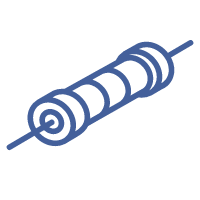
Analog Devices CR21-1210-FL
CR21-1210-FL
100-BQFP
39560039-CR21-1210-FL
- Mounting TypeSurface Mount
- Package / Case100-BQFP
- Surface Mount
having leads that are designed to be soldered on the side of a circuit board that the body of the component is mounted on.
YES - Terminal ShapeWRAPAROUND
- Mounting Feature
a process by which the operating system makes files and directories on a storage device (such as hard drive, CD-ROM, or network share) available for users to access via the computer's file system.
SURFACE MOUNT - Supplier Device Package100-QFP (14x20)
- Number of Terminals2
- Number of I/Os77
- PackageTray
- Base Product NumberMB90587
- MfrInfineon Technologies
- Data ConvertersA/D 8x8/10b; D/A 2x8b
- Product StatusDiscontinued at Digi-Key
- Package DescriptionSMT, 0805
- Package StyleSMT
- Operating Temperature-Min-55 °C
- Operating Temperature-Max155 °C
- Rohs CodeYes
- Manufacturer Part NumberCR21-1210-FL
- Package ShapeRECTANGULAR PACKAGE
- ManufacturerASJ Holdings Limited
- Package Height0.5 mm
- Part Life Cycle CodeActive
- Ihs ManufacturerASJ PTE LTD
- Package Length2 mm
- Risk Rank5.13
- Package Width1.25 mm
- Operating Temperature
The operating temperature is the range of ambient temperature within which a power supply, or any other electrical equipment, operate in. This ranges from a minimum operating temperature, to a peak or maximum operating temperature, outside which, the power supply may fail.
-40°C ~ 85°C (TA) - SeriesF²MC-16LX MB90580C
- Tolerance1%
- JESD-609 Codee3
- Pbfree CodeYes
- ECCN CodeEAR99
- Temperature Coefficient
The resistance-change factor per degree Celsius of temperature change is called the temperature coefficient of resistance. This factor is represented by the Greek lower-case letter “alpha” (α). A positive coefficient for a material means that its resistance increases with an increase in temperature.
100 ppm/°C - Resistance121 Ω
- Terminal FinishMatte Tin (Sn) - with Nickel (Ni) barrier
- HTS Code
HTS (Harmonized Tariff Schedule) codes are product classification codes between 8-1 digits. The first six digits are an HS code, and the countries of import assign the subsequent digits to provide additional classification. U.S. HTS codes are 1 digits and are administered by the U.S. International Trade Commission.
8533.21.00.30 - Packing MethodTR, PUNCHED PAPER, 7 INCH
- TechnologyMETAL GLAZE/THICK FILM
- ConstructionRectangular
- Resistor TypeFIXED RESISTOR
- Reach Compliance Codecompliant
- Reference StandardAEC-Q200
- Rated Power Dissipation (P)0.125 W
- Working Voltage150 V
- Size Code0805
- Rated Temperature70 °C
- Oscillator Type
Wien Bridge Oscillator; RC Phase Shift Oscillator; Hartley Oscillator; Voltage Controlled Oscillator; Colpitts Oscillator; Clapp Oscillators; Crystal Oscillators; Armstrong Oscillator.
External - Speed16MHz
- RAM Size4K x 8
- Voltage - Supply (Vcc/Vdd)3V ~ 5.5V
- Core ProcessorF²MC-16LX
- PeripheralsPOR, WDT
- Program Memory Type
Program memory typically refers to flash memory when it is used to hold the program (instructions). Program memory may also refer to a hard drive or solid state drive (SSD). Contrast with data memory.
Mask ROM - Core Size16-Bit
- Program Memory Size64KB (64K x 8)
- ConnectivitySCI, UART/USART
- EEPROM Size-
- Datasheets :








